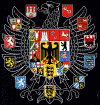Eltiste-Kaiser Web Site
Germany National Arms
The German eagle is already an old national symbol for the Kings and Emperors
of Germany, or its predecessors (to make it easy, the former Empire is named
Germany below, even though the name was not officially used until 1871).
Even though Charlemagne used an eagle as the national symbol around 800, he
claimed to be the successor of the Roman Emperors, who already used an eagle, it
was not until the end of the 12th century that the eagle was used in arms of the
Emperors. Before the end of the 12th century the eagle sometimes appears as the
national symbol, but mainly shown as a natural eagle.
The first known use of the eagle as arms of the Emperor or the Empire is a coin, minted in Maastricht (now in the Netherlands), dating from between 1172 and 1190. It shows a single-headed eagle
The use of an eagle was not limited to the German Emperors, at the same time the Counts of Saarwerden and Henneberg, the Kings of Bohemia, the Dukes of Austria and others used an eagle in their arms or as their symbol. In the 13th and 14th century many other noble families also used an eagle.
The Imperial Eagle was also used by all free cities, throughout the empire, examples are Mosbach, Aalen and, outside present Germany, Deventer.
The colours of the Imperial Eagle are already known from the 13th century, as being a black eagle on a golden field. These colours are thus also used by practically all Imperial cities. The origin of the colours is not known. It may be derived from the colours of the Staufen dynasty, who were the ruling dynasty at the time the arms were adopted. In any case, the basic colours have not changed since. The claws, legs, beak and tongue gradually became red. The first mentioning of red legs date from the early 14th century. The Zürich roll of arms from 1335 also shows a red tongue. The beak does not become red until the 18th century. Completely black eagles appear at the same time during the centuries.
The arms were covered by a crowned helmet with an eagle as a crest until 1330. In 1330, under the reign of Ludwig of Bavaria, the eagle in the crest was replaced by the wings of the Wittelsbach family (his dynasty). These remained until the 15th century. Afterwards crests are rarely used.
The original arms showed a single-headed eagle. Germany was an Empire, but after the death of an Emperor first a nobleman was chosen as King of Germany. He could be promoted to Emperor, but that did not always happen. Gradually thus two different arms appeared, a single-headed eagle for the Kings and a double-headed eagle for the Empire and the Emperor. The first mentioning of a double-headed eagle dates from 1250 in a roll of arms of Matthew of Paris for Emperor Friedrich II. In the next 180 years both arms were used indiscriminately. Emperor Sigismund finally decided the difference between the arms for the King and the Emperor.
![]()
 |

Family Indexes
Home Kaiser Eltiste Fink Rohrs
Thumbnail Family Photo Gallery Index
Last Up-Date 12/03/2006 11:15:04 PM